Violence Against Women and Girls Resource Guide: Disaster Risk Management Brief


Abstract: Violence against women and girls (VAWG) has negative impacts on physical and mental health. Health care settings provide a unique opportunity to identify VAWG survivors, provide critical support services, and prevent future harm. Ample studies have shown that natural disasters, including tsunamis, hurricanes, earthquakes, and floods, disproportionately affect women and girls, who are at greater risk of violence and exploitation than men and boys in the face of uprooted housing and traditional support structures, disrupted access to services, and both structural and social obstacles to accessing food, relief, supplies, and latrines.
This guide provides ethical and safety recommendations for VAWG interventions; key areas for integrating VAWG in disaster risk management; and recommended resources for integrating VAWG into health sector projects.
General questions for undertaking a Rapid Situation Analysis
http://www.vawgresourceguide.org/integrate

